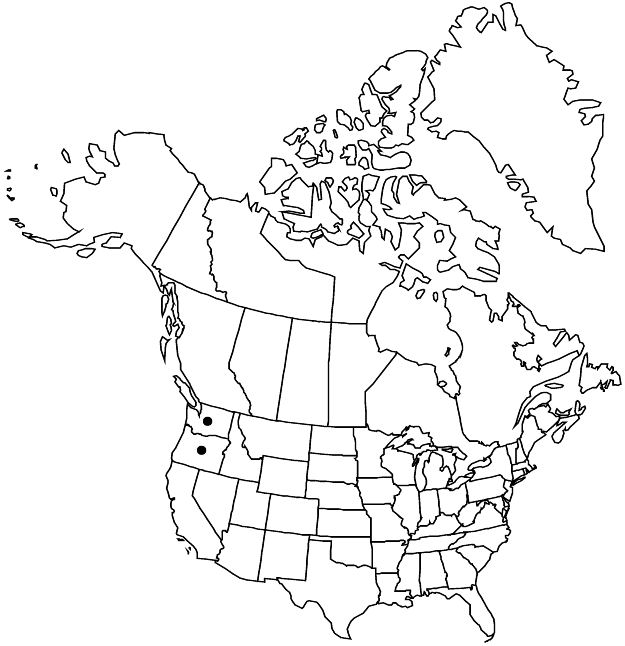Sidalcea virgata
Fl. N.W. Amer. 1: 101. 1897.
Herbs, perennial, 0.3–0.6 (–0.8) m, not glaucous, with woody taproot and compact rhizomes to 1 cm diam., these sometimes longer and freely rooting. Stems scattered or clustered, erect, decumbent-ascending, or reclining, freely rooting proximally, solid, proximally densely stellate-hairy, hairs long, soft, tangled, often 1.5 mm, distally hirsute to subglabrous, hairs smaller and appressed. Leaves basal and cauline; stipules sometimes purplish, linearlanceolate, 4–5 (–10) × 0.5–1.5 mm; petioles 10–20 cm on basal leaves, 3 times blade length, gradually reduced distally to 1/2 times blade length; blades: proximalmost orbiculate or semiorbiculate to cordate, shallowly 5–7-lobed, 2–10 (–15) × 2–10 (–15) cm, base cordate, apex rounded, lobe margins coarsely dentate, surfaces densely stellate-hairy abaxially, hairs often simple and appressed adaxially; mid cauline deeply, palmately 5–7 (–9) -lobed, lobes oblong, margins coarsely dentate; distal cauline smaller, deeply divided ± to base, lobe margins often entire. Inflorescences erect or ascending, often ± spiciform, usually open, sometimes dense, calyces usually not conspicuously overlapping except sometimes in bud, unbranched or rarely 1–3-branched, 5–20 (–30) -flowered, proximalmost 1 or 2 flowers usually leafy-bracted, spaced 1+ cm, elongate, slender and virgate, often 1-sided, 20–25 cm; bracts often purplish, linear to oblanceolate, usually 2-fid, 3–6 mm, usually equaling pedicels. Pedicels (2–) 3–8 (–15) mm; involucellar bractlets absent. Flowers bisexual or unisexual and pistillate, plants gynodioecious; calyx 6–12 mm, densely, finely stellate-hairy, without longer hairs, lobes green or purple-tinged; petals pink or pinkish lavender to magenta, usually drying purple, usually pale-veined, pistillate 9–10 mm, bisexual 15–28 (–30) mm; staminal column 6–8 mm, hairy; anthers white; stigmas 6 or 7 (or 8). Schizocarps 6–7 mm diam.; mericarps 6 or 7 (or 8), 3–3.5 (–4) mm, roughened, back glandularpuberulent to finely stellate, prominently reticulate-veined, pitted, mucro 0.5 mm. Seeds 1.5–2 mm. 2n = 20, 40.
Phenology: Flowering May–Jun(–Aug).
Habitat: Dry hillsides, open shrublands, meadows, forest margins
Elevation: 70–500(–800) m
Discussion
Sidalcea virgata was included as a subspecies within S. malviflora by C. L. Hitchcock (1957). It does have some resemblance to S. malviflora subsp. patula; the inflorescence is generally much more open, the rhizomes are not as long, and the stems are narrower and less hairy, and it tends to occur farther inland. It has been confused also with S. asprella and S. elegans, and the three appear to be closely related. Sidalcea virgata is somewhat difficult to define because it overlaps with other taxa in most of its characters, yet it has been generally accepted as distinct. Its range is well delineated but it is not always easily distinguished from sympatric species, especially in fruit. Its proximalmost flowers consistently being in the axils of well-developed leaves may be its most useful identification feature (especially in herbarium specimens). Hitchcock noted that it does not occur south of Oregon and considered it to be more geographically than morphologically distinct. It has been listed as endangered in Washington (as S. malviflora subsp. virgata); its single occurrence there needs more investigation. Sidalcea virgata is found in the Willamette Valley area and in Josephine to Yamhill counties, Oregon, and, possibly, in Thurston County, Washington.
Selected References
None.
Lower Taxa
"timesbladelength" is not declared as a valid unit of measurement for this property."-1/2timesbladelength" is not declared as a valid unit of measurement for this property."elongated" is not a number.
